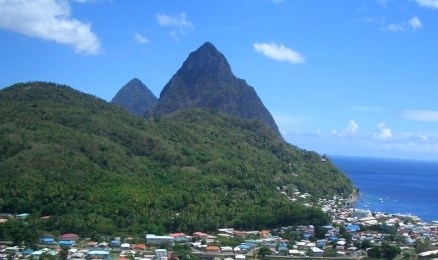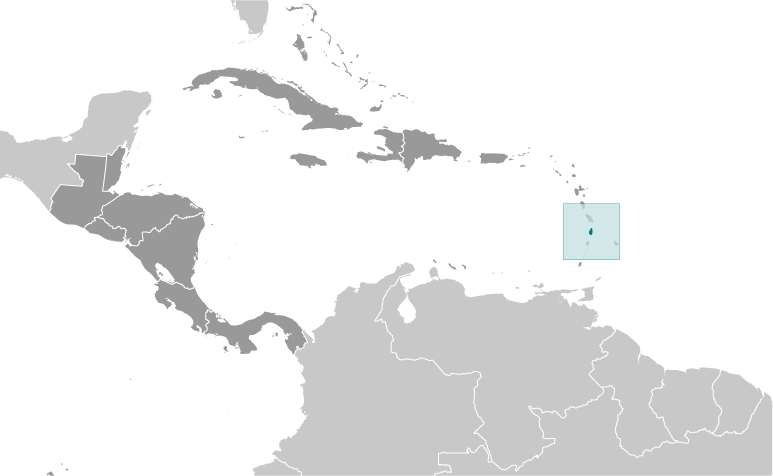Saint Lucia
Countries and Regions of the World Collection  Saint Lucia is an island nation of 162,000 people in the eastern Caribbean Sea on the boundary with the Atlantic Ocean.
Saint Lucia is an island nation of 162,000 people in the eastern Caribbean Sea on the boundary with the Atlantic Ocean.
It is located north/northeast of the islands of Saint Vincent and the Grenadines, northwest of Barbados and south of Martinique.
St. Lucia is one of the Windward Islands" of the Lesser Antilles, part of the West Indies.
The island, with its fine natural harbor at Castries, was contested between England and France throughout the 17th and early 18th centuries (changing possession 14 times); it was finally ceded to the UK in 1814.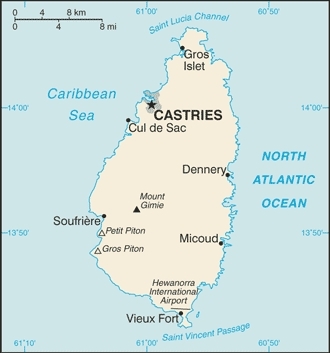
Even after the abolition of slavery on its plantations in 1834, Saint Lucia remained an agricultural island, dedicated to producing tropical commodity crops.
Self-government was granted in 1967 and independence in 1979.
Its major environmental issues include: deforestation; and, soil erosion, particularly in the northern region.
St. Lucia is susceptible to hurricanes and volcanic activity.
The the twin Pitons (Gros Piton and Petit Piton), striking cone-shaped peaks south of Soufriere, are one of the scenic natural highlights of the Caribbean.
Contents
Geography
Location: Caribbean, island between the Caribbean Sea and North Atlantic Ocean, north of Trinidad and Tobago
Geographic Coordinates:13 53 N, 60 58 W
Area: Total: 616 square km (606 sq km land and 10 sq km water)
arable land: 6.45%
permanent crops: 22.58%
other: 70.97% (2005)
Coastline:158 km
Maritime Claims: Territorial sea to 12 nautical miles; contiguous zone to 24 nautical miles; exclusive economic zone to 200 nautical miles; continental shelf to 200 nautical miles or to the edge of the continental margin
Natural Hazards: Hurricanes and volcanic activity
Terrain: Volcanic and mountainous with some broad, fertile valleys. The highest point is Mount Gimie 950 m
Climate: Tropical, moderated by northeast trade winds; dry season January to April, rainy season May to August
Ecology and Biodiversity
Ecoregions:
See also Biological diversity in the Caribbean Islands
People and Society
Population: 162,178 (July 2012 est.)
St. Lucia's population is predominantly of African and mixed African-European descent, with small East Indian and European minorities. English is the official language, although many St. Lucians speak a French patois. Ninety percent of the population is Roman Catholic, a further reflection of early French influence on the island. The population of just over 170,000 is evenly divided between urban and rural areas, although the capital, Castries, contains more than one-third of the population.
Ethnic groups: black 82.5%, mixed 11.9%, East Indian 2.4%, other or unspecified 3.1% (2001 census)
Age Structure:
0-14 years: 22.8% (male 18,925/female 17,945)
15-64 years: 67.5% (male 52,859/female 56,173)
65 years and over: 9.7% (male 7,074/female 8,581) (2011 est.)
Population Growth Rate: 0.378% (2012 est.)
Birthrate: 14.42 births/1,000 population (2012 est.)
Death Rate: 7.1 deaths/1,000 population (July 2012 est.)
Net Migration Rate: -3.54 migrant(s)/1,000 population (2012 est.)
Life Expectancy at Birth: 77.04 years
male: 74.34 years
female: 79.88 years (2012 est.)
Total Fertility Rate: 1.8 children born/woman (2012 est.)
Languages:English (official), French patois
Literacy: 90.1%
Urbanization: 28% of total population (2010) growing at a 1.6% annual rate of change (2010-15 est.)
History
St. Lucia's first known inhabitants were the Arawaks, believed to have come from northern South America in 200-400 A.D. Numerous archaeological sites on the island have produced specimens of the Arawaks' well-developed pottery. Caribs gradually replaced Arawaks during the period from 800-1000 A.D.
Europeans first landed on the island in either 1492 or 1502 during Spain's early exploration of the Caribbean. The Dutch, English, and French all tried to establish trading outposts on St. Lucia in the 17th century but faced opposition from the Caribs.
The English, with their headquarters in Barbados, and the French, based in Martinique, found St. Lucia attractive after the sugar industry developed in the 18th century. Britain eventually triumphed, with France permanently ceding St. Lucia in 1815. In 1838, St. Lucia was incorporated into the British Windward Islands administration, headquartered in Barbados. This lasted until 1885, when the capital was moved to Grenada.
Increasing self-governance has marked St. Lucia's 20th-century history. A 1924 constitution gave the island its first form of representative government, with a minority of elected members in the previously all-nominated legislative council. Universal adult suffrage was introduced in 1951, and elected members became a majority of the council. Ministerial government was introduced in 1956, and in 1958 St. Lucia joined the short-lived West Indies Federation, a semi-autonomous dependency of the United Kingdom. When the federation collapsed in 1962, following Jamaica's withdrawal, a smaller federation was briefly attempted. After the second failure, the United Kingdom and the six windward and leeward islands--Grenada, St. Vincent, Dominica, Antigua, St. Kitts-Nevis-Anguilla, and St. Lucia--developed a novel form of cooperation called associated statehood.
As an associated state of the United Kingdom from 1967 to 1979, St. Lucia had full responsibility for internal self-government but left its external affairs and defense responsibilities to the United Kingdom. This interim arrangement ended on February 22, 1979, when St. Lucia achieved full independence. St. Lucia continues to recognize Queen Elizabeth II as titular head of state and is an active member of the Commonwealth. The island continues to cooperate with its neighbors through the Caribbean Community and Common Market (CARICOM), the CARICOM Single Market and Economy (CSME), the East Caribbean Common Market (ECCM), the Organization of Eastern Caribbean States (OECS), and the Regional Security System (RSS).
Government
Government Type: parliamentary democracy and a Commonwealth realm
St. Lucia is a parliamentary democracy modeled on the Westminster system. The head of state is Queen Elizabeth II, represented by a governor general, appointed by the Queen as her representative. The governor general exercises ceremonial functions, but residual powers, under the constitution, can be used at the governor general's discretion. The actual power in St. Lucia lies with the prime minister and the cabinet, usually representing the majority party in parliament.
The bicameral parliament consists of a 17-member House of Assembly whose members are elected by universal adult suffrage for 5-year terms and an 11-member senate appointed by the governor general. The parliament may be dissolved by the governor general at any point during its 5-year term, either at the request of the prime minister--in order to take the nation into early elections--or at the governor general's own discretion, if the house passes a vote of no-confidence in the government.
Capital: Castries - 15,000 (2009)
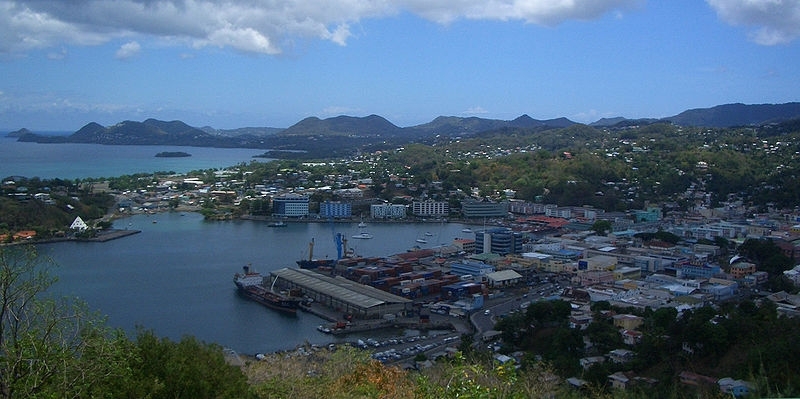
Castries: Source: Wikimedia Commons.
|
Administrative divisions: 11 quarters;
Independence Date: 22 February 1979 (from the UK) Legal System: English common law. st. Lucia has not submitted an International Court of Justice (ICJ) jurisdiction declaration; but, accepts International criminal court (ICCt) jurisdiction. St. Lucia has an independent judiciary composed of district courts and a high court. Cases may be appealed to the Eastern Caribbean Court of Appeals and, ultimately, to the Judicial Committee of the Privy Council in London. The island is divided into 10 administrative divisions, including the capital, Castries. Popularly elected local governments in most towns and villages perform such tasks as regulation of sanitation and markets and maintenance of cemeteries and secondary roads. St. Lucia has no army but maintains a coast guard and a paramilitary Special Services Unit within its police force. |
Source: Wikimedia Commons. |
International Environmental Agreements
Saint Lucia is party to international agreements on: Biodiversity, Climate Change, Climate Change-Kyoto Protocol, Desertification, Endangered Species, Environmental Modification, Hazardous Wastes, Law of the Sea, Marine Dumping, Ozone Layer Protection, Ship Pollution, Wetlands, and Whaling
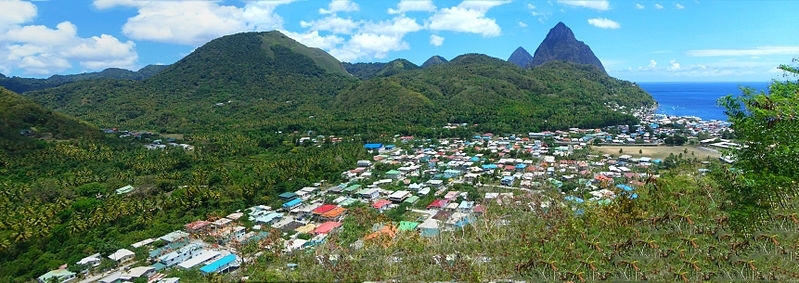
Soufrière, St Lucia, as seen from the road approaching it from the north, and in the background the twin peaks of Petit Piton and Gros Piton. Source: Wikimedia Commons.
Water
The island is subdivided into 37 water catchments or river basins from which a number of perennial streams emanate. Though a hydrological network was installed in the mid-1980s, the water resources available from these surface sources have not been quantified.
See Water profile (Water profile of St. Lucia)
Total Renewable Water Resources:
Freshwater Withdrawal: 0.01 81 cu km/yr (1997)
Per Capita Freshwater Withdrawal: 81 cu m/yr (1997)
Agriculture
Agricultural products: bananas, coconuts, vegetables, citrus, root crops, cocoa
Irrigated Land: 30 sq km (2008)
Resources
Natural Resources: forests, sandy beaches, minerals (pumice), mineral springs, geothermal potential
Land Use:
Economy
St. Lucia's economy depends primarily on revenue from tourism and banana production, with some contribution from small-scale manufacturing. All sectors of the economy have benefited from infrastructure improvements in roads, communications, water supply, sewerage, and port facilities. These improvements, combined with a stable political environment and educated work force, have attracted foreign investors in several different sectors. Although St. Lucia enjoys a steady flow of investment in tourism, the single most significant foreign investment is Hess Oil's large petroleum storage and transshipment terminal. In addition, the Caribbean Development Bank funded an extensive airport expansion project.
Although banana revenues have helped fund the country's development since the 1960s, the industry is now in a terminal decline, due to competition from lower-cost Latin American banana producers and reduced European Union trade preferences. The country is encouraging farmers to plant crops such as cocoa, mangos, and avocados to diversify its agricultural production and provide jobs for displaced banana workers.
Tourism recovered in 2004, following the post-September 11, 2001 recession, and continued to grow in 2005, making up more than 48% of St. Lucia's GDP. The hotel and restaurant industry grew by 6.3% during 2005. Stay-over arrivals increased by 6.5%, and the United States remained the most important market, accounting for 35.4% of these arrivals. Yacht passengers rose by 21.9%. Redeployment of cruise ships, remedial berth construction, and high fuel costs prevented higher growth rates. However, several investors have planned new tourism projects for the island, including a large hotel and resort in the southern part of the island. The global recession has caused a reduction in tourist revenue and foreign investment, significantly slowing growth rates.
St. Lucia's currency is the Eastern Caribbean Dollar (EC$), a regional currency shared among members of the Eastern Caribbean Currency Union (ECCU). The Eastern Caribbean Central Bank (ECCB) issues the EC$, manages monetary policy, and regulates and supervises commercial banking activities in its member countries. The ECCB has kept the EC$ pegged at EC$2.7=U.S. $1.
St. Lucia is a beneficiary of the U.S. Caribbean Basin Initiative and is a member of the Caribbean Community and Common Market (CARICOM). The country hosts the executive secretariat of the Organization of Eastern Caribbean States (OECS).
GDP: (Purchasing Power Parity): $2.142 billion (2011 est.)
GDP (official exchange rate): $1.3 billion (2011 est.)
GDP- per capita (PPP): $12,900 (2011 est.)
GDP- composition by sector:
agriculture: 4.1%
industry: 18.4%
services: 77.5% (2011 est.)
Industries: tourism; clothing, assembly of electronic components, beverages, corrugated cardboard boxes, lime processing, coconut processing
Currency: East Caribbean dollars (XCD)
